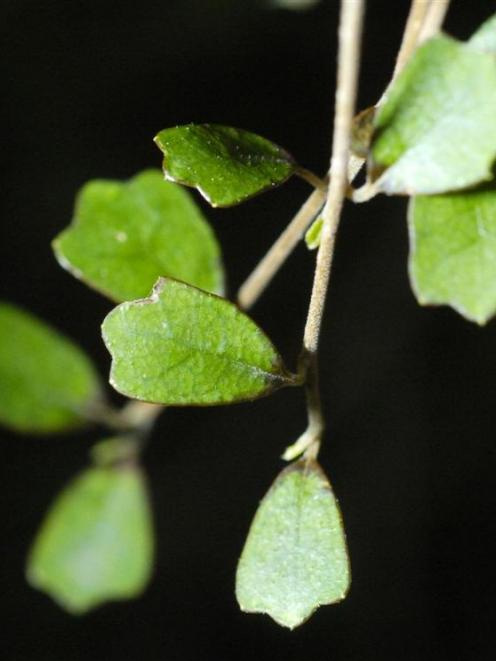
There are two species in New Zealand, both endemic.
While P. corymbosa, or kaikomako, is a fairly common small tree in lowland forest throughout the country, P. baylisiana exists as a single specimen on Manawa Tawhi (Great) Island of the Three Kings group.
In the garden
Pennantia baylisiana is quite unlike kaikomako.
It is a multi-trunked tree with large leathery leaves and is more similar to P. endlicheri of Norfolk Island.
Kaikomako has smaller leaves and a distinct divaricate or twiggy juvenile form.
At Dunedin Botanic Garden a group of juvenile kaikomako provides a neat contrast to surrounding shrubs and ferns in the Myrtaceae border of the native plant collection.
In the bush
Occurring naturally in the bush around Dunedin, kaikomako can be distinguished from other small-leaved divaricate shrubs by the duck-foot shape of the leaves.
Each leaf has three to five lobes pointing forward, with the lower part of the leaf tapering to a short leaf stalk.
When growing in the open, kaikomako will reach 2-3m before making an abrupt change to adult form.
However, beneath the adult foliage the tree may retain some of the twiggy interlaced growth of its youth for a few years.
Adult trees grow to about 10m.
The leaves lose the distinctive shape of their juvenile years, becoming larger, with many rounded teeth.
Panicles of scented flowers appear as the tree matures.
From late spring to summer functional male and female flowers are borne on separate plants.
From midsummer to autumn blackberry-like fruit is produced on the female trees.
Grow your own
If propagating by semi-hardwood cuttings, the juvenile stage can be bypassed by taking material from adult foliage.
If you want the satisfaction of growing kaikomako through its juvenile stage to maturity then go for seed.
Give the seed a light sanding then put it in the fridge in damp sphagnum moss or similar for a month before sowing.
Shirley Stuart is curator of the New Zealand native plant collection at Dunedin Botanic Garden.












